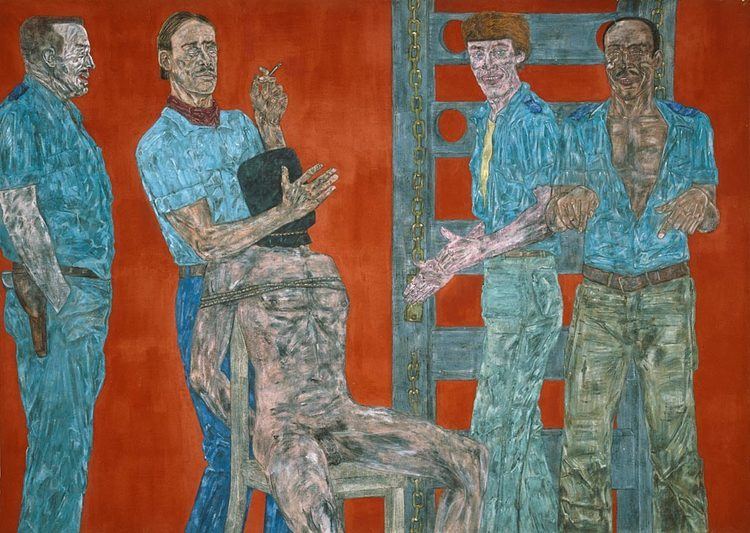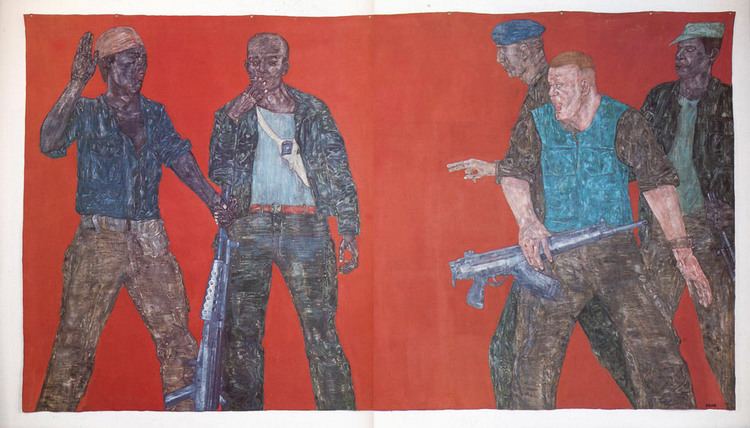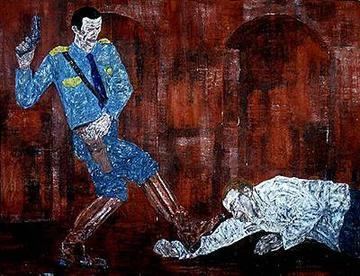Known for Painting | Name Leon Golub Role Painter | |
 | ||
Movement NO IdeologyMonster Roster Died August 8, 2004, New York City, New York, United States Artwork Interrogation II, Interrogation III, White Squad V, Head (I) Children Paul Golub, Philip Golub, Stephen Golub Similar People Nancy Spero, Jay Pasachoff, Gordon Quinn, Enrique Martinez Celaya, Joseph Beuys | ||
Leon golub process
Leon Golub (January 23, 1922 – August 8, 2004) was an American painter. He was born in Chicago, Illinois, where he also studied, receiving his BA at the University of Chicago in 1942, and his BFA and MFA at the Art Institute of Chicago in 1949 and 1950, respectively.
Contents
- Leon golub process
- Leon golub did it at ronald feldman
- Early life
- Career
- 2001 renaissance
- Retrospectives
- Selected public collections
- Selected private foundations
- Selected private collections
- Films and videos
- References

He was married to and collaborated with the artist Nancy Spero (1926 – October 18, 2009). Their son Stephen Golub is an economics professor at Swarthmore College. Their son Philip Golub is Professor of International and Comparative Politics at the American University of Paris and was a longstanding contributing editor of the influential journal Le Monde diplomatique. Their youngest son Paul Golub is a theater director and acting teacher working in France.

Leon golub did it at ronald feldman
Early life

Born in Chicago in 1922, Golub received his B.A. in Art History from the University of Chicago in 1942. From 1947 to 1949 he studied, under the G.I. Bill, at the School of the Art Institute of Chicago, where he met the artist Nancy Spero, to whom he was married for nearly fifty years. In Chicago he became involved with other painters, known as the Monster Roster group, which believed that an observable connection to the external world and to actual events was essential if a painting was to have any relevance to the viewer or society. This is a view that informed Golub's work throughout his career.
Career

Golub, who always painted in a figural style, drew upon diverse representations of the body from ancient Greek and Roman sculpture, to photographs of athletic competitions, to gay pornography; often pulled directly from a huge database he assembled of journalistic images from the mass media. He likened his painting process to sculptural technique and employed a method of layering and scraping away paint, sometimes using a meat cleaver, leaving varying amounts of canvas untouched.
From 1959 through 1964, Golub and his wife Nancy Spero opted to live in Europe, a move occasioned in part by the belief that Europe would be more receptive to their work dealing overtly with issues of power, sexual and political. During this period Golub's work increased in size because of larger available studio space and the inspiration of the French tradition of large-scale history painting. He also switched from using lacquer to acrylics, left more of the surface unpainted, and began to grind the paint directly into the canvas. While in Italy, both Golub and Spero were profoundly influenced by the figurative works of Etruscan and Roman art, whose narratives addressed ancient themes of power and violence.
When Golub returned to New York State, the Vietnam War was escalating, and he responded with his two series: Napalm and Vietnam. He and Spero became active with Artists and Writers Protest, "the first such group to take a public stand against the war". In 1967 as part of the group's Angry Arts Week, Golub organized The Collage of Indignation, a collaborative work by over 150 artists which he described as "not political art, but rather an expression of popular revulsion."
In the mid-1970s, Golub was beset with self-doubt. He destroyed or cut up many works he produced up to this period and nearly abandoned painting. In the late seventies, however, he produced more than a hundred portraits of public figures, among them political leaders, dictators, and religious figures. Leon Golub: Paintings, 1950-2000 includes several portraits of Nelson Rockefeller and Ho Chi Minh, along with images of Fidel Castro, Francisco Franco, Richard Nixon, and Henry Kissinger.
In the 1980s, Golub turned his attention to terrorism in a variety of forms, from the subversive operations of governments to urban street violence. Killing fields, torture chambers, bars, and brothels became inspiration and subject for work that dealt with such themes as violent aggression, racial inequality, gender ambiguity, oppression, and exclusion. Among the work produced in this period are the series Mercenaries, Interrogation, Riot, and Horsing Around.
From the nineties to his death, Golub's work shifted toward the illusionistic, with forms semi-visible, and appropriated graphic styles from ancient carvings, medieval manuscripts, and contemporary graffiti. As an older man he began to consider his own mortality, and moved toward themes of separation, loss, and death. Text appeared in many of the paintings combined with a series of symbolic references, including dogs, lions, skulls, and skeletons.
Golub's work was seen in solo exhibitions throughout the world, among them World Wide (1991), a Grand Lobby project at the Brooklyn Museum of Art. For World Wide the artist created a process, repeated in exhibitions at several other museums, by which he enlarged images and details from his paintings and screened them on transparent sheets of vinyl, hung so that they surround the viewer. He was represented in many group exhibitions and was one of the few white artists included in Black Male: Representations of Masculinity in Contemporary American Art at the Whitney Museum of American Art in 1994.
In 1996, Golub was given a commission to design a set of stained glass windows for Temple Sholom in Chicago, the four windows depict the life of Joseph. These would be the only stained glass windows Leon Golub ever did. They were fabricated in New York by Victor Rothman and Gene Mallard.
2001: renaissance
While Leon Golub's later works from the 1990s offer more fragmented (in his words "left-over") reincarnations of his early messages, it is his larger, carved works, vividly depicting power relations that have re-gained attention with the U.S.'s involvement in Iraq and Afghanistan.
In 2003, Golub revisited his 1959 painting, Reclining Youth, part of a series of paintings inspired by friezes at the Great Altar of Zeus in Pergamon. Working with Magnolia Editions, the artist translated the painting into a large-scale [14-foot-wide (4.3 m)] Jacquard tapestry, his first and only textile work.
Retrospectives
From March to May 2015 the Serpentine Gallery in London held a career retrospective which was "spunoff" and presented as a three-floor career retrospective at the Manhattan Hauser & Wirth in June 2015.
